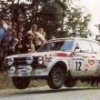The suggestion has been raised that the offender in an on-track accident should bear some if not all of the cost of repairing the other party's race car This could be 100%, 75% 50% or 0%.
If something is not done, then more owners will leave their precious cars in sheds and not bring them out so we can see how they used to run. This not what we want.
After all, on the open road the offender in an accident is responsible for the repairs to both parties' vehicles.
Here is an Editorial from Vintage Racecar magazine on this topic.
Presented for consideration and your comments.
If you’ve been around historic racing for any amount of time, then you will be familiar with one of the most self-limiting factors of the sport… the chilling effect of accidents. Funny enough, it isn’t the prospect of bodily harm that keeps owners from bringing their prized possessions out on the track, it is the risk of having their valuable investments damaged by some idiot consumed with the “red mist.”
This has always been an underlining problem, but as significant cars have steadily migrated up into the millions—if not the tens of millions of dollars—range it has become increasingly rare to see any number of Ferraris, Porsches and even Jaguars out competing at anything but the most exclusive and prestigious events…. and now, even those events might be in question.
I received an email recently from Duncan Wiltshire, leader of Motor Racing Legends, which among other events, organizes stunning fields at events like Le Mans and Silverstone Classic. In his email, Wiltshire struck an uncharacteristically grave tone, “It will have escaped no one’s attention that the tremendous success of last weekend’s Classic was marred by a small number of serious lapses in driving standards in some of our grids. Whilst racing accidents will, and do, happen, it is clear from the responses received since the weekend that I am not alone in finding the level of needless damage that occurred unacceptable. Across two of our grids, eleven cars suffered serious damage. That’s eleven cars whose owners are now looking at substantial rebuild expenses resulting from avoidable accidents.”
“Please have your accountant contact my fabricator."
As a result, Wiltshire is considering adopting what amounts to historic racing’s equivalent of the nuclear option…shared financial liability. Wiltshire stated, “What is clear is that something must be done. It is well known that one Continental organizer requires any driver held responsible for accident damage to another car is expected to cover 50% of the cost of that car’s repair bill. Extreme, perhaps, but driving standards are reported to be excellent as a result.”
Nothing dissipates the red mist like a firm draining of the checking account. Can you imagine the instantaneous calculus that might now occur as a driver contemplates, first his/her line, then the closing speed and finally the most recent auction sales on the Maserati Birdcage he/she is considering dive-bombing? Pre-race checklists might now have to include current 401K balances, as well as tire pressures.
Is this an extreme measure? Yes. Will this stifle hammer-and-tongs racing? Most likely. But really, that is the underlining philosophical dilemma. We love to see the old cars really racing. But there comes a point in time, in the extended life cycle of something treasured, where that really is no longer practical or sensible. So we’re left with the existential question, do we want to see fewer and fewer of these cars “racing” on track, or can we be happy with seeing a larger selection of these significant vehicles being exercised with vigor and a reserved degree of caution. My hunch is that Duncan may be on the leading edge of a broader movement that will eventually sweep across all the big, international events. If not, those events will eventually shrivel away themselves.
Of course, this does raise the unintended consequence that, if implemented, now only the richest drivers will drive like assholes!
All the best,
Casey Annis, Editor




























